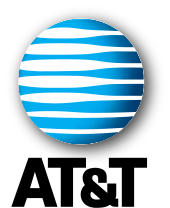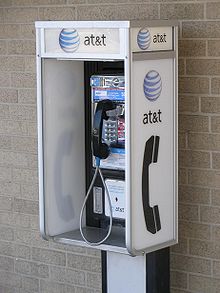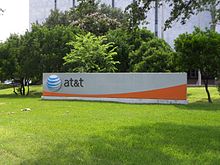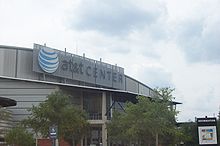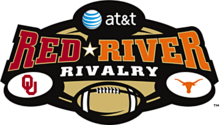- AT&T
-
This article is about the company known as AT&T since 2005 and formerly SBC. For the original AT&T founded in 1885, see AT&T Corporation. For the mobile telephony provider, see AT&T Mobility. For other uses, see AT&T (disambiguation).
AT&T Inc. 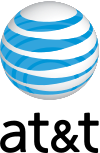
Type Public Traded as NYSE: T
NYSE: ATT
Dow Jones Component
S&P 500 ComponentIndustry Telecommunications Founded October 5, 1983[1] Headquarters Whitacre Tower, Downtown,
Dallas, Texas, United StatesKey people Randall Stephenson
(Chairman, President & CEO)[2]Services Fixed line and mobile telephony, broadband and fixed-line internet services, digital television Revenue  US$ 124.280 billion (2010)[3]
US$ 124.280 billion (2010)[3]Operating income  US$ 19.573 billion (2010)[3]
US$ 19.573 billion (2010)[3]Net income  US$ 19.864 billion (2010)[3]
US$ 19.864 billion (2010)[3]Total assets  US$ 268.488 billion (2010)[3]
US$ 268.488 billion (2010)[3]Total equity  US$ 111.950 billion (2010)[3]
US$ 111.950 billion (2010)[3]Employees 294,600 (2010)[3] Parent AT&T Corp. (1983) Subsidiaries AT&T Corp.
AT&T Mobility
AT&T Teleholdings
BellSouth
Southwestern BellWebsite ATT.com  Whitacre Tower: AT&T's corporate headquarters in Dallas, Texas
Whitacre Tower: AT&T's corporate headquarters in Dallas, Texas
AT&T Inc. (NYSE: T) is an American multinational telecommunications corporation headquartered in Whitacre Tower, Dallas, Texas, United States. It is the largest provider of mobile telephony and fixed telephony in the United States, and is also a provider of broadband and subscription television services. As of 2010[update], AT&T is the 7th largest company in the United States by total revenue, as well as the 4th largest non-oil company in the US (behind Walmart, General Electric and Bank of America). It is the 3rd largest company in Texas by total revenue (behind ExxonMobil and ConocoPhillips) and the largest non-oil company in Texas. It is also the largest company headquartered in Dallas.[4] In 2011, Forbes listed AT&T as the 14th largest company in the world by market value[5] and the 9th largest non-oil company in the world by market value.[6] It is the 21st largest mobile telecom operator in the world with over 100.7 million mobile customers. [7]
Southwestern Bell Corporation was one of seven Regional Bell Operating Companies that were incorporated in 1983 by AT&T Corp following the break-up of the original AT&T as a result of the United States v. AT&T antitrust suit. The company changed its name in 1995 to SBC Communications Inc. and again in 2005 to AT&T Inc. after it purchased its former parent company, AT&T Corporation. The newly merged company took on the iconic AT&T logo and stock-trading symbol (NYSE: T, for "telephone").
The current AT&T reconstitutes much of the former Bell System and includes ten of the original 22 Bell Operating Companies along with one it partially owned (Southern New England Telephone), and the original long distance division.[8] The company is headquartered in downtown Dallas, Texas.[9]
History
1984–1995: Southwestern Bell Corporation
American Telephone and Telegraph Company officially transferred full ownership of Southwestern Bell Telephone Company to Southwestern Bell Corporation on January 1, 1984. It had three other subsidiaries: Southwestern Bell Publications, Inc., a directory publisher; Southwestern Bell Mobile Systems, Inc., in the business of mobile telephone service; and Southwestern Bell Telecommunications, Inc., focusing on marketing phone equipment to business customers. The holding companies' new president was Zane Edison Barnes.
In 1987, SBC bought Metromedia Inc.'s cellular and paging business. This in turn boosted the company to third largest cellular-communications company in the United States; behind McCaw Cellular and Pacific Telesis. In January 1990 Edward Whitacre took over as president of Southwestern Bell. The Headquarters was moved from St. Louis to San Antonio, Texas in February 1993. It acquired 2 cable companies in Maryland and Virginia from Hauser Communications for 650 million dollars, becoming the first regional Bell telephone company to acquire a cable company outside of its service area. In 1994 they called off a $1.6 billion acquisition attempt for 40 percent of Cox Cable due to FCC rules on cable companies. SBC would later start selling its current cable company interests.
1995–2000: Changes in the company
In 1995 Southwestern Bell Corp. became SBC Communications. They then combined Southwestern Bell Telecom division (which made telephone equipment) into the company, due to new FCC rules.
In 1996 SBC announced it would acquire Pacific Telesis Group, a Regional Bell Operating Company (RBOC) in California and Nevada. 1997 brought rumors of a proposed merger between AT&T Corporation (the USA's largest long distance provider) and SBC (the USA's largest local provider). The FCC disapproved of the merger, and it came to end. Later in 1997 SBC sold its last two cable companies, exiting the cable telecom field.
January 1998, SBC announced it would take over Southern New England Telecommunications Corp. (SNET) for $4.4 billion in stock (the FCC would approve in October 1998). SBC also won a court judgment that would make it easier for RBOCs to enter the long distance phone service, but it was being challenged by AT&T and the FCC. May 1998 Ameritech and SBC announced a $62 billion dollar merger, in which SBC would take over Ameritech. After making several organizational changes (such as the sale of Ameritech Wireless to GTE) to satisfy state and federal regulators, the two merged on October 8, 1999. The FCC later fined SBC Communications $6 million for failure to comply with agreements made in order to secure approval of the merger. SBC became the largest RBOC until the Bell Atlantic and GTE merger. 1998 revenues were $46 billion, placing SBC among the top 15 companies in the Fortune 500.
January 1999 SBC announced it would purchase Comcast Cellular, for $1.7 billion, plus $1.3 billion of debt. During 1999 SBC continued to prepare to be allowed to provide long distance phone service. February SBC acquired up to ten percent of Williams Companies' telecommunications division for about $500 million, who was building a fiber optic network across the country and would carry SBC's future service. On November 1, 1999, SBC became a part of the Dow Jones Industrial Average.
2000–2005: One national brand, AT&T Corp. acquisition
In 2002, SBC ended marketing its operating companies under different names, and simply opted to give its companies different doing business as names based on the state (a practice already in use by Ameritech since 1993), and it gave the holding companies it had purchased d/b/a names based on their general region.
On January 31, 2005, SBC announced that it would purchase AT&T Corporation for more than US$16 billion. The announcement came almost eight years after SBC and AT&T (also known as American Telephone & Telegraph Corp.) called off their first merger talks and nearly a year after initial merger talks between AT&T Corp. and BellSouth fell apart. AT&T stockholders meeting in Denver, approved the merger on June 30, 2005. The U.S. Department of Justice cleared the merger on October 27, 2005, and the Federal Communications Commission approved it on October 31, 2005.
The merger was finalized on November 18, 2005.[10] Upon the completion of the merger, SBC Communications adopted the AT&T branding, and changed its corporate name to AT&T Inc. to differentiate the company from the former AT&T Corporation. On December 1, 2005, the merged company's New York Stock Exchange ticker symbol was changed from "SBC" to the traditional "T" used by AT&T.
The new AT&T updated the former AT&T's graphic logo (a new "marble" took over the "Death Star"); however the existing AT&T sound trademark (voiced by Pat Fleet) continues to be used.
BellSouth acquisition
On Friday December 29, 2006, the Federal Communications Commission (FCC) approved the new AT&T's acquisition of a regional Bell Operating Company, BellSouth, valued at approximately $86 billion (or 1.325 shares of AT&T for each share of BellSouth at the close of trading December 29, 2006).[11] The new combined company retained the name AT&T.[12] The deal consolidated ownership of both Cingular Wireless and Yellowpages.com, once joint ventures between BellSouth and AT&T. All services, including wireless, became offered under the AT&T name.[13]
2007–2008 restructuring
Transition to new media
In June 2007, AT&T's new chairman and CEO, Randall Stephenson, discussed how wireless services are the core of "The New AT&T".[14] With declining sales of traditional home phone lines, AT&T plans to roll out various new media such as Video Share, U-verse, and to extend its reach in high speed Internet into rural areas across the country. AT&T announced on June 29, 2007, however, that it was acquiring Dobson Communications. It was then reported on October 2, 2007 that AT&T would purchase Interwise[clarification needed] for $121 million, which it completed on November 2, 2007. On October 9, 2007, AT&T purchased 12 MHz of spectrum in the prime 700 MHz spectrum band from privately held Aloha Partners for nearly $2.5 billion; the deal was approved by the FCC on February 4, 2008. On December 4, 2007 AT&T announced plans to acquire Edge Wireless, a regional GSM carrier in the Pacific Northwest.[15] The Edge Wireless acquisition was completed in April 2008.[16]
Corporate headquarters move
On June 27, 2008, AT&T announced that it would move its corporate headquarters from 175 East Houston Street in San Antonio to One AT&T Plaza in Downtown Dallas.[9][17] The company said that it moved to gain better access to its customers and operations throughout the world, and to the key technology partners, suppliers, innovation and human resources needed as it continues to grow, domestically and internationally[18]
AT&T Inc. previously relocated its corporate headquarters to San Antonio from St. Louis in 1992, when it was then named Southwestern Bell Corporation. The company's Telecom Operations group, which serves residential and regional business customers in 22 U.S. states, remains in San Antonio.[citation needed]
Atlanta continues to be the headquarters for AT&T Mobility, with significant offices in Redmond, Washington, the former home of AT&T Wireless. Bedminster, New Jersey is the headquarters for the company's Global Business Services group and AT&T Labs. St. Louis continues as home to the company's Directory operations, AT&T Advertising Solutions.[19]
Job cuts
On December 4, 2008, AT&T announced they would be cutting 12,000 jobs due to "economic pressures, a changing business mix and a more streamlined organizational structure".[20]
Post-consolidation wireless acquisitions
Cellular One acquisition
On June 29, 2007 AT&T announced that they had reached an agreement to purchase Dobson Cellular, which provided services in the US under the name Cellular One in primarily rural areas. The closing price was $2.8B USD, or $13 per share. AT&T also agreed to assume the outstanding debt of $2.3B USD. The sale completed on November 15, 2007, with market transition beginning December 9, 2007.[21]
Centennial acquisition
On November 11, 2008, AT&T announced a $944 million buyout of Centennial Communications Corp. The acquisition is subject to regulatory approval, the approval of Centennial’s stockholders and other customary closing conditions. Welsh, Carson, Anderson & Stowe, Centennial’s largest stockholder, has agreed to vote in support of this transaction. In an attempt to quell regulators, on May 9, 2009 AT&T entered an agreement with Verizon Wireless to sell off certain existing Centennial service areas in the states of Louisiana and Mississippi for $240 million pending the successful merger of AT&T and Centennial.[22]
Wayport acquisition
On December 12, 2008, AT&T acquired Wayport, Inc., a major provider of Internet hotspots in the United States. With the acquisition, AT&T's public Wi-Fi deployment climbed to 20,000 hotspots in the United States, the most of any U.S. provider.[23]
Qualcomm spectrum
On December 20, 2010, AT&T and Qualcomm announced that AT&T would buy $1.93 billion worth of spectrum from Qualcomm. Formerly used for FLO TV, this spectrum will be used to expand AT&T's 4G wireless services. AT&T already had spectrum for the purpose close to what it is buying.[24]
T-Mobile USA acquisition
Main article: Merger of AT&T and T-Mobile USAOn March 20, 2011, AT&T announced its intention to buy T-Mobile USA for $39 billion from Deutsche Telekom. The deal comes with 33.7 million subscribers, making AT&T the largest mobile phone company in the United States.[25][26] If the deal goes through AT&T would have a 43% market share of mobile phones in the U.S. making AT&T significantly larger than any of its competitors. Regulators question the effects such a deal will have on both competitors and consumers.[25] AT&T CEO Randall Stephenson however stated that the merger would increase network quality and would lead to large savings for the company. AT&T stated it may have to sell some asset to gain approval from regulators, but state they have done their "homework" on regulations.[27]
Reaction to the announced merger has generated both support as well as opposition among various groups and communities.
The merger has garnered support from a wide number of civil rights, environmental, and business organizations. These include the NAACP, League of United Latin American Citizens, Gay & Lesbian Alliance Against Defamation (GLAAD), League of United Latin American Citizens (LULAC), and the Sierra Club.[28] Labor organizations such as the AFL-CIO, Teamsters, and the Communications Workers of America also voiced support for the merger. These organizations point to AT&T's commitment to labor, social, and environmental standards. Many of these organizations have also cited how the merger is likely to accelerate 4G wireless deployment, thus helping underserved communities such as rural areas and disadvantaged urban communities.[28] According to the NAACP, the merger will "advance increased access to affordable and sustainable wireless broadband services and in turn stimulate job creation and civic engagement throughout our country."[28]
As of August 2 the governors of 26 states have written letters supporting the merger.[29] On July 27 the attorneys general of Utah, Alabama, Arkansas, Georgia, Kentucky, Michigan, Mississippi, North Dakota, South Dakota, West Virginia, and Wyoming sent a joint letter of support to the FCC.[29] As of August 2011 state regulatory agencies in Arizona and Louisiana have approved the acquisition.
A diverse group of industry and public-interest organizations are opposed to AT&T's merger with T-Mobile. Consumer groups including Public Knowledge, Consumers Union, Free Press and the Media Access Project are publicly opposed to AT&T merger. These groups have influence with Democrats at the Federal Communications Commission and in Congress. These organizations fear that the merger will raise prices and stifle innovation by consolidating so much of the wireless industry in one company. Free Press and Public Knowledge have started letter-writing campaigns against the deal.[30]
Internet companies are generally skeptical of the merger because it leaves them with fewer counter-parties to negotiate with for getting their content and applications to customers. The AT&T merger might leave them dependent on just two, AT&T and Verizon. The Computer & Communication Industry Association (CCIA), which counts Google, Microsoft, Yahoo and eBay among its members, is opposed to the merger. "A deal like this, if not blocked on antitrust grounds, is of deep concern to all the innovative businesses that build everything from apps to handsets. It would be hypocritical for our nation to talk about unleashing innovation on one hand and then stand by as threats to innovation like this are proposed," said Ed Black, head of CCIA.[30]
On April 21, 2011, AT&T defended its proposed acquisition of T-Mobile USA before a U.S. Senate committee, saying the combined company will deliver high-speed wireless services to 97 percent of Americans and provide consumer benefits such as fewer dropped calls.[31]
If AT&T's acquisition of T-Mobile USA is rejected by federal regulators, AT&T would need to pay $6 billion, including $3 billion in cash, to T-Mobile USA's parent company Deutsche Telekom.[32]
On August 31, 2011, the Department of Justice officially filed a lawsuit in the United States District Court for the District of Columbia seeking to block the acquisition. [33][34]
Bell Operating Companies
Of the twenty-two Bell Operating Companies which AT&T Corp. owned prior to the 1984 agreement to divest, eleven (BellSouth Telecommunications combines two former BOCs) have become a part of the new AT&T Inc. with the completion of their acquisition of BellSouth Corporation on December 29, 2006:[35]
- BellSouth Telecommunications (formerly known as Southern Bell; includes former South Central Bell)
- Illinois Bell
- Indiana Bell
- Michigan Bell
- Nevada Bell (formerly known as Bell Telephone Company of Nevada)
- Ohio Bell
- Pacific Bell (formerly Pacific Telephone & Telegraph)
- Southwestern Bell
- Wisconsin Bell (formerly Wisconsin Telephone)
- Southern New England Telephone – Now wholly owned; the original AT&T held 16.8% interest prior to 1984.
Former operating companies
The following companies have gone to defunct status under SBC/AT&T ownership:
- Southwestern Bell Texas – a separate operating company created by SBC, absorbed operations of original SWBT on December 30, 2001 and became Southwestern Bell Telephone, L.P.; eventually merged into SWBT Inc. in 2007 which became the current Southwestern Bell
- Woodbury Telephone – merged into Southern New England Telephone on June 1, 2007.
Corporate structure
AT&T office in San Antonio, Texas with new logo and orange highlight from the former Cingular
AT&T Inc. has retained the holding companies it has acquired over the years resulting in the following corporate structure:
- AT&T Inc., publicly traded holding company
- Southwestern Bell Telephone Company d/b/a AT&T Arkansas, AT&T Kansas, AT&T Missouri, AT&T Oklahoma, AT&T Southwest, AT&T Texas
- AT&T Teleholdings, Inc. d/b/a AT&T East, AT&T Midwest, AT&T West; formerly Ameritech, acquired in 1999; absorbed Pacific Telesis and SNET Corp. under AT&T ownership
- Illinois Bell Telephone Company d/b/a AT&T Illinois
- Indiana Bell Telephone Company d/b/a AT&T Indiana
- Michigan Bell Telephone Company d/b/a AT&T Michigan
- The Ohio Bell Telephone Company d/b/a AT&T Ohio
- Pacific Bell Telephone Company d/b/a AT&T California
- Nevada Bell Telephone Company d/b/a AT&T Nevada
- The Southern New England Telephone Company d/b/a AT&T Connecticut (includes former Woodbury Telephone)
- Wisconsin Bell, Inc. d/b/a AT&T Wisconsin
- AT&T Corp., acquired 2005
- BellSouth Corporation d/b/a AT&T South, acquired 2006
- BellSouth Telecommunications, LLC d/b/a AT&T Alabama, AT&T Florida, AT&T Georgia, AT&T Louisiana, AT&T Kentucky, AT&T Mississippi, AT&T North Carolina, AT&T South Carolina, AT&T Southeast, AT&T Tennessee
- AT&T Mobility
Corporate governance
 Stephenson at the 2008 World Economic Forum
Stephenson at the 2008 World Economic Forum
AT&T's current board of directors:[36]
- Randall L. Stephenson – Chairman and Chief Executive Officer
- James A. Henderson
- Gilbert F. Amelio
- Reuben V. Anderson
- James H. Blanchard
- Jaime Chico Pardo
- James P. Kelly
- Jon C. Madonna
- Lynn M. Martin
- John B. McCoy
- Joyce M. Roché
- Matthew K. Rose
- Laura D'Andrea Tyson
Criticism and controversies
Contributions to political campaigns
According to the Center for Responsive Politics, AT&T is the US' second largest donor to political campaigns, having contributed more than US$ 36 million since 1990, 56% and 44% of which went to Republican and Democratic recipients, respectively. A key political issue for AT&T is the question of which businesses win the right to profit by providing broadband internet access in the United States.[37]
In 2005, AT&T was among 53 entities that contributed the maximum of $250,000 to the second inauguration of President George W. Bush.[38][39][40]
Wireless service
AT&T has received criticisms for its wireless services. In December 2010, Consumer Reports named AT&T as the worst wireless provider in the country.[41]
Censorship
In August 2009, the band Pearl Jam performed in Chicago at Lollapalooza which was being web-broadcast by AT&T. The band, while playing the song "Daughter", started playing a version of Pink Floyd's "Another Brick in the Wall" but with altered lyrics critical of president George Bush. These lyrics included "George Bush, leave this world alone!" and, "George Bush, find yourself another home!". Listeners to AT&T's web broadcast heard only the first line because the rest was censored,[42] although AT&T spokesman Michael Coe said that the silencing was "a mistake."[43]
In September 2007, AT&T changed[44] their legal policy to state that "AT&T may immediately terminate or suspend all or a portion of your Service, any Member ID, electronic mail address, IP address, Universal Resource Locator or domain name used by you, without notice for conduct that AT&T believes"..."(c) tends to damage the name or reputation of AT&T, or its parents, affiliates and subsidiaries."[45] By October 10, 2007 AT&T had altered the terms and conditions for its Internet service to explicitly support freedom of expression by its subscribers, after an outcry claiming the company had given itself the right to censor its subscribers' transmissions.[46]
Section 5.1 of AT&T's new terms of service now reads "AT&T respects freedom of expression and believes it is a foundation of our free society to express differing points of view. AT&T will not terminate, disconnect or suspend service because of the views you or we express on public policy matters, political issues or political campaigns."[47][dubious ]
On July 26, 2009, AT&T customers were unable to access certain sections of the image board 4chan, specifically /b/ (the "random" board) and /r9k/ (the "ROBOT 9000" board, a spin-off of the random board).[48] However, by the morning of Monday, July 27, the block had been lifted and access to the affected boards was restored. AT&T's official reason for the block was that a distributed denial of service attack had originated from the img.4chan.org server, and access was blocked to stop the attack.[49] Major news outlets have reported that the issue may be related to DDoSing of 4chan and IP spoofing of 4chan and that the suspicions of 4chan users fell on Kimmo Alm, the person who owned Anontalk.com at that time for doing this.[50] Alm has been reported in the past to have DDoSed 4chan.[51]
Privacy controversy
Further information: NSA call database, Mark Klein, NSA warrantless surveillance controversy, Hepting v. AT&TIn 2006, the Electronic Frontier Foundation lodged a class action lawsuit, Hepting v. AT&T, which alleged that AT&T had allowed agents of the National Security Agency (NSA) to monitor phone and Internet communications of AT&T customers without warrants. If true, this would violate the Foreign Intelligence Surveillance Act of 1978 and the First and Fourth Amendments of the U.S. Constitution. AT&T has yet to confirm or deny that monitoring by the NSA is occurring. In April 2006, a retired former AT&T technician, Mark Klein, lodged an affidavit supporting this allegation.[53][54] The Department of Justice has stated they will intervene in this lawsuit by means of State Secrets Privilege.[55] In July 2006, the United States District Court for the Northern District of California – in which the suit was filed – rejected a federal government motion to dismiss the case. The motion to dismiss, which invoked the State Secrets Privilege, had argued that any court review of the alleged partnership between the federal government and AT&T would harm national security. The case was immediately appealed to the Ninth Circuit. It was dismissed on June 3, 2009, citing retroactive legislation in the Foreign Intelligence Surveillance Act. [56] In May 2006, USA Today reported that all international and domestic calling records had been handed over to the National Security Agency by AT&T, Verizon, SBC, and BellSouth for the purpose of creating a massive calling database.[57] The portions of the new AT&T that had been part of SBC Communications before November 18, 2005 were not mentioned.
On June 21, 2006, the San Francisco Chronicle reported that AT&T had rewritten rules on their privacy policy. The policy, which took effect June 23, 2006, says that "AT&T – not customers – owns customers' confidential info and can use it 'to protect its legitimate business interests, safeguard others, or respond to legal process.' "[58]
On August 22, 2007, National Intelligence Director Mike McConnell confirmed that AT&T was one of the telecommunications companies that assisted with the government's warrantless wire-tapping program on calls between foreign and domestic sources.[59]
On November 8, 2007, Mark Klein, a former AT&T technician, told Keith Olbermann of MSNBC that all Internet traffic passing over AT&T lines was copied into a locked room at the company's San Francisco office – to which only employees with National Security Agency clearance had access.[60]
AT&T keeps for five to seven years a record of who text messages who and the date and time, but not the content of the messages.[61]
Intellectual property filtering
In January 2008, the company reported plans to begin filtering all Internet traffic which passes through its network for intellectual property violations.[62] Commentators in the media have speculated that if this plan is implemented, it would lead to a mass exodus of subscribers leaving AT&T,[63] although this is misleading as Internet traffic may go through the company's network anyway.[62] Internet freedom proponents used these developments as justification for government-mandated network neutrality.
Discrimination against local Public-access television channels
AT&T is accused by community media groups of discriminating against local Public, educational, and government access (PEG) cable TV channels:, by "imposing unfair restrictions that will severely restrict the audience".[64]
According to Barbara Popovic, Executive Director of the Chicago public-access service CAN-TV, the new AT&T U-verse system forces all Public-access television into a special menu system, denying normal functionality such as channel numbers, access to the standard program guide, and DVR recording.[64] The Ratepayer Advocates division of the California Public Utilities Commission reported: "Instead of putting the stations on individual channels, AT&T has bundled community stations into a generic channel that can only be navigated through a complex and lengthy process."[64]
Sue Buske (president of telecommunications consulting firm the Buske Group and a former head of the National Federation of Local Cable Programmers/Alliance for Community Media) argue that this is "an overall attack [...] on public access across the [United States], the place in the dial around cities and communities where people can make their own media in their own communities".[64]
Information security
In June 2010, a hacker group known as Goatse Security discovered a vulnerability within the AT&T that could allow anyone to uncover email addresses belonging to customers of AT&T 3G service for the Apple iPad.[65] These email addresses could be accessed without a protective password.[66] Using a script, Goatse Security collected thousands of email addresses from AT&T.[65] Goatse Security informed AT&T about the security flaw through a third party.[67] Goatse Security then disclosed around 114,000 of these emails to Gawker Media, which published an article about the security flaw and disclosure in Valleywag.[65][67] Praetorian Security Group criticized the web application that Goatse Security exploited as "poorly designed".[65]
Naming rights and sponsorships
Buildings
- AT&T 220 Building – building in Indianapolis, Indiana
- AT&T Building – building in Detroit, Michigan
- AT&T Building – building in Indianapolis, Indiana
- AT&T Building – building in Kingman, Arizona
- AT&T Building – (aka "The Batman Building") in Nashville, Tennessee
- AT&T Building – building in Omaha, Nebraska
- AT&T Building Addition – building in Detroit, Michigan
- AT&T Center – building in Los Angeles
- AT&T Center – building in St. Louis, Missouri
- AT&T City Center – building in Birmingham, Alabama
- AT&T Corporate Center – building in Chicago, Illinois
- AT&T Huron Road Building – building in Cleveland, Ohio
- AT&T Lenox Park Campus – AT&T Mobility Headquarters in DeKalb County just outside Atlanta, Georgia
- AT&T Midtown Center – building in Atlanta, Georgia
- AT&T Switching Center – building in Los Angeles
- AT&T Switching Center – building in Oakland, California
- AT&T Switching Center – building in San Francisco
- AT&T Building – building in San Diego
- Whitacre Tower (One AT&T Plaza) – Corporate Headquarters, Dallas, Texas
- Sony Tower, (formerly the AT&T Building)
- AT&T Tower – building in Jacksonville, FL
Venues
- AT&T Bricktown Ballpark – Oklahoma City, Oklahoma (formerly Southwestern Bell Bricktown Ballpark, SBC Bricktown Ballpark)
- AT&T Center – San Antonio, Texas (formerly SBC Center)
- AT&T Field – Chattanooga, Tennessee (formerly BellSouth Park)
- AT&T Park – San Francisco (formerly Pacific Bell Park, SBC Park)
- AT&T Plaza – Chicago, Illinois (public space that hosts the Cloud Gate sculpture in Millennium Park)
- AT&T Plaza – Dallas, Texas (plaza in front of the American Airlines Center at Victory Park)
- AT&T Performing Arts Center – Dallas, Texas
- Jones AT&T Stadium – Lubbock, Texas (formerly Clifford B. and Audrey Jones Stadium, Jones SBC Stadium)
- TPC San Antonio – San Antonio, Texas (AT&T Oaks Course & AT&T Canyons Course)
Sponsorships
- AT&T Champions Classic – Valencia, California
- AT&T Classic – Atlanta, Georgia (formerly BellSouth Classic)
- AT&T Cotton Bowl Classic (formerly Mobil Cotton Bowl Classic, Southwestern Bell Cotton Bowl Classic, SBC Cotton Bowl Classic) – played in Arlington, Texas, at Cowboys Stadium.
- AT&T National – Washington, D.C.
- AT&T Pebble Beach National Pro-Am
- AT&T Red River Rivalry – Dallas, Texas (formerly Red River Shootout, SBC Red River Rivalry)
- AT&T WilliamsF1 Team – based in Grove, Oxfordshire, United Kingdom
- Major League Soccer and the United States Soccer Federation, including the U.S. men's and U.S. women's national teams and the Major League Soccer All-Star Game from 2009
- United States Olympic team[68]
- National Collegiate Athletic Association (Corporate Champion)[69]
Miscellaneous
- AT&T (SEPTA station) – Public Transportation Station in Philadelphia, PA
Global presence
AT&T offers services in many locations throughout the Asia Pacific; its regional headquarters is located in Hong Kong.[70]
Enterprise SIP Trunking Services
In 2008, Toshiba announced SIP interoperability with the AT&T IP Flexible Reach service, and this partnership would improve Toshiba's IP-PBX offerings.[71] In 2010, AT&T combined its virtual private network (VPN) service with its IP Flexible Reach.[72]
See also
- AT&T Corporation
- AT&T Connect
- AT&T Mobility
- att.net
- Bell System
- Bell System Divestiture
- Communications Assistance For Law Enforcement Act
- Hepting v. AT&T
- Lists of public utilities
- Modification of Final Judgment
- NSA warrantless surveillance
- PRX (telephony)
- Regional Bell Operating Company
- Toktumi
- Tying of the iPhone to AT&T
References
- ^ "Sec 8-k" (Press release). AT&T. April 28, 2006. http://yahoo.brand.edgar-online.com/EFX_dll/EDGARpro.dll?FetchFilingHTML1?SessionID=jaJ3juNdQ_X7dSV&ID=4390374. Retrieved September 29, 2007.
- ^ "Randall L. Stephenson, Chairman, Chief Executive Officer and President". http://www.att.com/gen/investor-relations?pid=7824. Retrieved August 14, 2011.
- ^ a b c d e f "2010 Form 10-K, AT&T Inc". United States Securities and Exchange Commission. http://www.sec.gov/Archives/edgar/data/732717/000073271711000014/ex13.htm.
- ^ "Fortune 500 2010: States: Texas Companies - FORTUNE on CNNMoney.com". Money. May 3, 2010. http://money.cnn.com/magazines/fortune/fortune500/2010/states/TX.html. Retrieved August 14, 2010.
- ^ "AT&T". Forbes. http://www.forbes.com/companies/att/. Retrieved June 6, 2011.
- ^ "The World's Biggest Public Companies". Forbes. http://www.forbes.com/global2000/. Retrieved June 6, 2011.
- ^ http://www.corp.att.com/emea/insights/pr/eng/q4_270111.html
- ^ Kleinfield, Sonny (1981). The biggest company on earth: a profile of AT&T. New York: Holt, Rinehart, and Winston. ISBN 978-0-03-045326-7.
- ^ a b Godinez, Victor and David McLemore. "AT&T moving headquarters to Dallas from San Antonio." The Dallas Morning News. Saturday June 28, 2008. Retrieved on June 18, 2009.
- ^ "New AT&T Launches" (Press release). AT&T. November 18, 2005. http://www.att.com/gen/press-room?pid=4800&cdvn=news&newsarticleid=21906. Retrieved September 29, 2007.
- ^ Vorman, Julie (December 29, 2006). "AT&T closes $86 billion BellSouth deal". Reuters. http://www.reuters.com/article/ousiv/idUSWBT00636120070102. Retrieved September 29, 2007.
- ^ Bartash, Jeffry; Jonathan Burton (March 5, 2006). "AT&T to pay $67 billion for BellSouth". Dow Jones Market Watch. http://www.marketwatch.com/News/Story/Story.aspx?guid={6E4D6E93-004F-4938-9692-B2704970428B}&siteid=mktw&dist=. Retrieved September 29, 2007.
- ^ "AT&T and BellSouth Join to Create a Premier Global Communications Company" (Press release). AT&T. December 29, 2006. http://www.att.com/gen/press-room?pid=4800&cdvn=news&newsarticleid=22860. Retrieved September 29, 2007.
- ^ Johnson, K C (June 24, 2007). "AT&T's new chief dialed in". Chicago Tribune. http://www.chicagotribune.com/business/chi-sun_front_0624jun24,0,3337832.story?track=rss. Retrieved June 27, 2007.
- ^ "AT&T Buys Edge Wireless". Phone Scoop. December 4, 2007. http://www.phonescoop.com/news/item.php?n=2569. Retrieved July 26, 2008.
- ^ Antonio, San (April 18, 2008). "AT&T completes buy out of Edge Wireless". American City Business Journals. http://www.bizjournals.com/sanantonio/stories/2008/04/14/daily37.html. Retrieved July 26, 2008.
- ^ "Corporate Inquiries." AT&T. Retrieved on March 25, 2009.
- ^ Source: Dallas News
- ^ AT&T – News Room (June 27, 2008). AT&T Corporate Headquarters to Move to Dallas. Press release. Retrieved on June 27, 2008.
- ^ "Job cuts mount as year-end nears" (Press release). AT&T. December 4, 2008. http://money.cnn.com/2008/12/04/news/companies/ATNT/index.htm?postversion=2008120409.
- ^ "AT&T Completes Acquisition of Dobson Communications to Enhance Wireless Coverage" (Press release). Dallas, Texas: AT&T Inc.. November 15, 2007. http://www.att.com/gen/press-room?pid=4800&cdvn=news&newsarticleid=24739. Retrieved May 11, 2009.
- ^ "AT&T Agrees to Sell Certain Centennial Communications Corp. Assets to Verizon Wireless" (Webpage). www.newsticker.welt.de. April 9, 2009. http://newsticker.welt.de/?module=smarthouse&id=885963=. Retrieved May 9, 2009.[dead link]
- ^ "AT&T Advanced Wi-Fi Strategy" (Press release). Dallas, Texas: AT&T Inc.. December 12, 2008. http://www.wayport.com/NewsReleases.aspx?id=2030. Retrieved December 22, 2008.
- ^ "AT&T buys $2 billion worth of 4G spectrum from Qualcomm". News & Record. Associated Press. December 20, 2010. http://www.news-record.com/content/2010/12/20/article/att_buys_2_billion_worth_of_4g_spectrum_from_qualcomm. Retrieved December 20, 2010.
- ^ a b "AT&T to Buy T-Mobile USA for $39 billion". New York Times. March 20, 2011. http://dealbook.nytimes.com/2011/03/20/att-to-buy-t-mobile-usa-for-39-billion/?hp. Retrieved March 20, 2011.
- ^ AT&T Buys T-Mobile: Great For Them, Bad For You
- ^ BBC.co.uk
- ^ a b c German, Kent. "On Call: Civil rights groups line up behind AT&T-T-Mobile merger". CNET. http://www.cnet.com/8301-17918_1-20070630-85/on-call-civil-rights-groups-line-up-behind-at-t-t-mobile-merger/?tag=mncol;txt. Retrieved 17 August 2011.
- ^ a b German, Kent. "States weigh in on AT&T-T-Mobile merger". CNET. http://www.cnet.com/8301-17918_1-20070911-85/states-weigh-in-on-at-t-t-mobile-merger/?tag=mncol;txt. Retrieved 17 August 2011.
- ^ a b Sara Jerome (March 23, 2011). "T-Mobile, AT&T merger to draw torrent of opposition". The Hill.
- ^ Declan McCullagh, CNET. "AT&T defends T-Mobile deal to U.S. Senate." May 11, 2011. Retrieved May 11, 2011.
- ^ Don Reisinger, CNET. "Report: AT&T pays $6B if T-Mobile deal fails." May 13, 2011. Retrieved May 13, 2011.
- ^ http://www.bloomberg.com/news/2011-08-31/u-s-files-antitrust-complaint-to-block-proposed-at-t-t-mobile-merger.html
- ^ http://money.cnn.com/2011/09/01/technology/att_tmobile_lawsuit/index.htm?hpt=hp_t2
- ^ "Agreements Between SNET America, Inc. (SAI) DBA AT&T Long Distance East, and AT&T Telephone Companies". AT&T. Archived from the original on October 11, 2007. http://web.archive.org/web/20071011214558/http://att.com/gen/public-affairs?pid=8101. Retrieved September 29, 2007.
- ^ Current board of directors at AT&T.com
- ^ "AT&T Inc". The Center For Responsive Politics. http://www.opensecrets.org/orgs/summary.asp?ID=D000000076&Name=AT%26T+Inc. Retrieved September 29, 2007.
- ^ Drinkard, Jim (January 17, 2005). "Donors get good seats, great access this week". USA Today. http://www.usatoday.com/news/washington/2005-01-16-inauguration-donors_x.htm. Retrieved May 25, 2008.
- ^ "Financing the inauguration". USA Today. January 16, 2005. http://www.usatoday.com/news/washington/2005-01-16-inaugural-donors_x.htm. Retrieved May 25, 2008.
- ^ "Some question inaugural's multi-million price tag". USA Today. January 14, 2005. http://www.usatoday.com/news/washington/2005-01-14-price_x.htm. Retrieved May 25, 2008.
- ^ "Consumer Reports Names AT&T Worst Wireless Service Provider". Time. December 6, 2010. http://techland.time.com/2010/12/06/consumer-reports-names-att-worst-wireless-service-provider/. Retrieved December 6, 2010.
- ^ Grossberg, Josh (August 9, 2007). "AT&T's Pearl Jamming?". E Online. http://www.eonline.com/news/article/index.jsp?uuid=4de684ae-62eb-4b23-984c-d07ce72ea5e2. Retrieved September 29, 2007.
- ^ Roberts, Michelle (August 10, 2007). "AT&T: Pearl Jam edit a mistake". The Seattle Times. Associated Press. http://seattletimes.nwsource.com/html/nationworld/2003829996_pearljam10.html?syndication=rss. Retrieved September 29, 2007.
- ^ AT&T threatens to disconnect subscribers who criticize the company
- ^ "AT&T Legal Policy". AT&T. http://home.bellsouth.net/csbellsouth/s/s.dll?spage=cg/legal/att.htm&leg=tos. Retrieved September 29, 2007.
- ^ AT&T Changes Terms Of Service After Outcry
- ^ AT&T Legal Policy
- ^ Kincaid, Jason (July 26, 2009). "AT&T Reportedly Blocks 4chan. This Is Going To Get Ugly". TechCrunch. http://www.techcrunch.com/2009/07/26/att-blocks-4chan-this-is-going-to-get-ugly/. Retrieved July 27, 2009.
- ^ Cheng, Jacqui (July 27, 2009). "AT&T: 4chan block due to DDoS attack coming from 4chan IPs". Ars Technica. http://arstechnica.com/telecom/news/2009/07/att-4chan-block-due-to-ddos-attack-coming-from-4chan-ips.ars. Retrieved July 28, 2009.
- ^ Feared Hackers Call Off Attack on AT&T. Tuesday, July 28, 2009. Retrieved July 28, 2009
- ^ When Your Pedicurist Is A Fish (dated July 22, 2008) Transcript of National Public Radio news interview. Retrieved July 28, 2009
- ^ "Klein Exhibit" Document from Hepting vs AT&T lawsuit from 2007. Reported by Ryan Singel in Wired Magazine, article "AT&T 'Spy Room' Documents Unsealed; You've Already Seen Them" June 13, 2007, Documents posted at the Electronic Frontier Foundation website: (File "SER_klein_exhibits.pdf")
- ^ Nakashima, Ellen, "A Story of Surveillance", Washington Post, November 7, 2007
- ^ Singel, Ryan (April 7, 2006). "Whistle-Blower Outs NSA Spy Room". Wired. http://www.wired.com/science/discoveries/news/2006/04/70619. Retrieved September 29, 2007.
- ^ "Government Moves to Intervene in AT&T Surveillance Case" (Press release). Electronic Frontier Foundation (EFF). April 28, 2006. http://www.eff.org/news/archives/2006_04.php#004613. Retrieved September 29, 2007.
- ^ U-verse
- ^ Cauley, Leslie (May 11, 2006). "NSA has massive database of Americans' phone calls". USA Today. http://www.usatoday.com/news/washington/2006-05-10-nsa_x.htm. Retrieved September 29, 2007.
- ^ Lazarus, David (June 21, 2006). "AT&T Rewrites Rules: Your Data Isn't Yours". San Francisco Chronicle. http://www.sfgate.com/cgi-bin/article.cgi?f=/c/a/2006/06/21/BUG9VJHB9C1.DTL&hw=at&sn=002&sc=870. Retrieved September 29, 2007.
- ^ Shrader, Katherine (August 22, 2007). "Spy Chief Reveals Classified Surveillance Details". Associated Press. http://www.msnbc.msn.com/id/20396282/. Retrieved September 29, 2007.
- ^ Olbermann, Keith (November 8, 2007). "Whistleblower Saw AT&T Assist Bush Administration". MSNBC. http://video.msn.com/video.aspx?mkt=en-US&brand=msnbc&vid=297abdd5-d0dc-4617-a6c9-c482fa316b59. Retrieved November 10, 2007.
- ^ "Document Shows How Phone Cos. Treat Private Data". Associated Press. September 29, 2011. http://www.npr.org/templates/story/story.php?storyId=140931876. Retrieved 2011-09-29. "T-Mobile USA doesn't keep any information on Web browsing activity. Verizon, on the other hand, keeps some information for up to a year that can be used to ascertain if a particular phone visited a particular Web site. According to the sheet, Sprint Nextel Corp.'s Virgin Mobile brand keeps the text content of text messages for three months. Verizon keeps it for three to five days. None of the other carriers keep texts at all, but they keep records of who texted who for more than a year. The document says AT&T keeps for five to seven years a record of who text messages who —and when, but not the content of the messages. Virgin Mobile only keeps that data for two to three months."
- ^ a b Wu, Tim (January 16, 2008). "Has AT&T Lost Its Mind? A baffling proposal to filter the Internet". Slate. http://www.slate.com/id/2182152/.
- ^ AT&T's Proposed Filtering Policy Is Bad News – Netiquette – MSNBC.com
- ^ a b c d (March 9, 2009) "AT&T Accused of Discriminating Against Local Public Access Channels, Deadline for Public Comment Expires Tonight", Democracy Now!, retrieved on March 13, 2009.
- ^ a b c d Keizer, Gregg (June 10, 2010). "'Brute force' script snatched iPad e-mail addresses". Computerworld. http://www.computerworld.com/s/article/9177921/_Brute_force_script_snatched_iPad_e_mail_addresses. Retrieved September 18, 2010.
- ^ Keizer, Gregg (June 11, 2010). "iPad e-mail hackers defend attack as 'ethical'". Computerworld: p. 2. http://www.computerworld.com/s/article/9177991/iPad_e_mail_hackers_defend_attack_as_ethical_?taxonomyId=17&pageNumber=2. Retrieved September 25, 2010.
- ^ a b Keizer, Gregg (June 11, 2010). "iPad e-mail hackers defend attack as 'ethical'". Computerworld: p. 1. http://www.computerworld.com/s/article/9177991/iPad_e_mail_hackers_defend_attack_as_ethical_. Retrieved September 25, 2010.
- ^ Teamusa.org
- ^ NCAA.org
- ^ Corp.att.com
- ^ Matthew Nickasch, Network World. "Toshiba Announces AT&T SIP Trunking Interoperability." August 19, 2008. Retrieved October 12, 2011.
- ^ Paul Korzeniowski, Information Week. "AT&T VPN Service Gains Its Voice." August 24, 2010. Retrieved October 12, 2011.
External links
- Corporate information
- Official website
- Brand evolution of AT&T companies
- AT&T History and science resources at The Franklin Institute's Case Files online exhibit
- Press Release announcing FCC Approval of SBC-Ameritech merger (October 6, 1999)
- Articles
- Thierer, Adam D.. "Unnatural Monopoly: Critical Moments in the Development of the Bell System Monopoly". cato.org. http://www.cato.org/pubs/journal/cjv14n2-6.html.
- "AT&T buys IBM's Global Network". BBC News. December 8, 1998. http://news.bbc.co.uk/1/hi/business/the_company_file/230831.stm.
- Reardon, Marguerite (November 18, 2005). "SBC closes AT&T acquisition". CNet News. http://news.cnet.com/SBC+closes+AT38T+acquisition/2100-1036_3-5961206.html.
- Reardon, Marguerite (March 5, 2006). "AT&T to buy BellSouth for $67 billion". CNet News. http://news.cnet.com/AT38T+to+buy+BellSouth+for+67+billion/2100-1037_3-6046081.html.
- "AT&T Whistleblower to Urge Senate to Reject Blanket Immunity for Telecoms". Electronic Frontier Foundation. http://www.eff.org/press/archives/2007/11/05.
AT&T Inc. Corporate directors Holding companies Operating Companies Competitive local exchange carrier Long distance services AT&T Mobility Ameritech Mobile Communications · AT&T Wireless · BellSouth Mobility · BellSouth Mobility DCS · Dobson Communications · Houston Cellular · Pacific Bell Wireless · Pacific Bell Wireless Northwest · SBC Wireless · SNET Mobility · Southwestern Bell Mobile Systems · Southwestern Bell WirelessInternet services Ameritech Interactive Media Services · Pacific Bell Internet Services · Prodigy · SNET Diversified Group · Southwestern Bell Internet ServicesOther ISPsAT&T Advertising Solutions Intellectual property Research and development Categories:- Companies listed on the New York Stock Exchange
- Telecommunications companies of the United States
- 1983 establishments in the United States
- AT&T
- Bell System
- Companies based in Dallas, Texas
- Companies established in 1983
- Dow Jones Industrial Average
- Internet service providers of the United States
- Multinational companies headquartered in the United States
- Publicly traded companies
- Tier 1 networks
Wikimedia Foundation. 2010.



